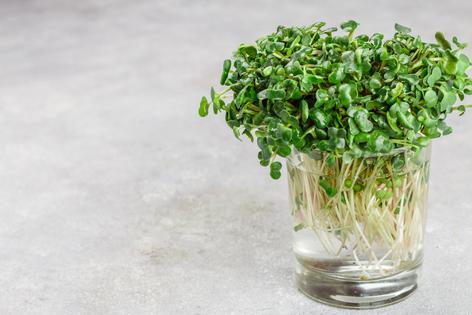Environmental Nutrition: Mighty microgreens
Microgreens are the seedlings, or baby plants, of vegetables and herbs.
The folklore
Microgreens may be true to their name in terms of their tiny size and verdant hue, but when it comes to reputation, "macrogreens" would be a much better fit! Since their 1980s debut in California restaurants, these wispy greens have culled a big following. Still trending on the dining scene, they're a go-to at farmers markets and are a favorite to grow in backyard gardens and on windowsills. And why not? These gems pack a powerful nutritional punch, come in a dizzying number of varieties, and add a burst of flavor and color to any dish.
The facts
Harvested between one and three inches tall (at about one to three weeks), microgreens are older than a sprout (sprouts don't have leaves, microgreens' leaves have just appeared) yet not quite a baby green. Varieties such as broccoli, radish, beet, spinach, cucumber and garlic, barely scratch the surface of the vast number available. Each differs in taste and nutrients, resembling those of the fully-grown counterpart. A one-cup serving of mixed microgreens packs 60% DV (DV=Daily Value, based on 2,000 calories/day) of eye-protecting vitamin A and 12% DV of antioxidant vitamin C.
The findings
Microgreens have a higher concentration -- from four to forty times as many by weight -- of many nutrients than their fully-grown counterparts (Journal of Agricultural and Food Chemistry, 2012). A 2017 study on broccoli microgreens found this to be most pronounced when microgreens were grown in compost. The average concentration ratio of broccoli microgreens to mature broccoli was 1.73 in amounts of vitamin K, magnesium, manganese, zinc, iron, calcium, niacin, and copper, and flavonoids. Microgreens also require less water, time, fertilizer, pesticides and energy-demanding transport from farm to table than the nutritionally equivalent amount of the grown vegetable (Frontiers in Nutrition).
The finer points
Increasingly available at specialty food markets, farmers markets and online, microgreens are easier than ever to enjoy at home. They can be bought already cut in single and mixed varieties or whole and cut at home. Microgreens are also a snap to grow from seed. Try many different varieties that range from strong and spicy, tangy, or bitter to mild and neutral in flavor. Use them in sandwiches, wraps and salads, as toppers on pizzas and frittatas, as a lovely garnish on avocado toast or on a favorite appetizer like bruschetta.
...continued







